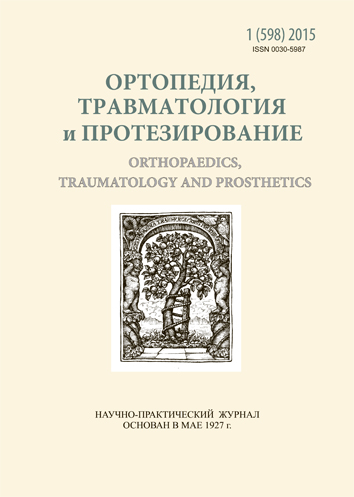The role and importance of deformities of the greater trochanter of the femur for hip function: development of working classification
DOI:
https://doi.org/10.15674/0030-59872015172-78Keywords:
hip, greater trochanter, pathology, children, classificationAbstract
On the basis of radiometric studies to identify possible options for the deviations in the structure of the greater trochanter (gt) in the pathology of the hip joint (hj) of various origins, to develop a working classification of its deformations (abnormal location) for further substantiation of methods of surgical treatment. methods: we performed a retrospective analysis of clinical examination and radiological diagnostics (x-ray, ct and mri) to compare the development of a trochanteric component of hj in 153 children with varying of its pathology (congenital dislocation and subluxation of the hip, deformation of the proximal femur due to injuries and inflammatory disorders, sepsis, suppurative arthritis, etc.) coxavara, aseptic necrosis of the femoral head, and hj patholog y on a background of neurological diseases (cerebral palsy, spinal hernia). results: there were identified and classified options of violation in gt structure as well as its spatial deviation from the norm with respect to the center of rotation of the femoral head in children with hj disorders of various origins. the most pronounced changes in the trochanteric component of hj were established in the case of inflammatory diseases carried in the period from birth to 6 years. changes of gt in cases of hj pathology of other genesis depend on the age at which it is developed, the area and the extent of damage in growth zones of the trochanter and the femoral head, peculiarities of pathology, treatment, the rate of growth of the child. firstly developed working classification of gt deformations in children for integrated assessment of hj, in particular its trochanteric component will create in the future a diagnostic and treatment algorithm of welltimed diagnostics, prediction and early surgical treatment, will lead to better anatomical and functional outcomes in patients with this pathology.
References
- Dysplasia of thigh joints in formation of the combined pathology of children at the early age/ O.A. Malakhov, U.S. Akoev, E.G. Chernavina [and others] the VIII-th conference of traumatic-orthopedists of the Republic of Belarus (Minsk the 16-17-th of October, 2008) - Minsk, 2008.-p.192-195.
- The therapy of the congenital dislocation of the hip (new technologies of the osteosynthesis with the help of modules of Ilizarov frame) [Shevtsov V.I., Makushin V.D., Teplenkiy M.P., Atmanskiy I.A.].-Kurgan: Zaurale, 2006-1000 p.
- Sokolovskiy A.M. Congenital coxa vara./ O.A. Sokolovskiy, R.K. Goldman// Medical news.-2006.-#12.-p. 7-16.
- Surgeries planning on the proximal femoral. A.M. Sokolovskiy, O.A. Sokolovskiy, R.K. Goldman, A.B. Dementsov// Medical news.-2005-#10.-p.26-29.
- Tonnis D. Congenital dysplasia and dislocation of the hip in children and adult / D. Tonnis. — New York: Springer, 1987. — 461 p.
- Yanson Kh.A. Biomechanics of the human's lower limb./ Kh.A. Yanson.-Riga: Zinantne, 1975.-324p.
- Korolkov O.I. The role of the greater trochanter in progression of the pathology of the thigh joint (medimatics) O.I. Korolkov, A.B. Gromov, M.Yu. Karpinskiy// Chronicles of the traumatology and orthopedy. - 2013 - № 1-2 (25-26). - P. 21-29.
- McCarthy J. J. Greater trochanteric epiphysiodesis / J. J. McCarthy, D. S. Weiner // Int Orthop. — 2008. — Vol. 32 (4). — P. 531–534.
- Herring J. A. Tachdjian’s pediatric orthopedics. Vol. 1 / J. A. Herring eds. — W. R. Sannders Company, 2014. — P. 610–611.
- Trochanteric advancement in patients with legg-calvé-perthes disease does not improve pain or limp / S. Y. Joo, K. S. Lee, I. H. Koh [et al.] // Clin. Orthop. Relat. Res. — 2008. — Vol. 466 (4). — P. 927–934, doi: 10.1007/s11999-008-0128-4.
- Zhuk P.M. The dynamics of the anatomo-functional changes in the congenital dislocation of the hip and the preventive treatment of the functional insufficiency of the locomotorium: sum. ...Dr.scient.med: 14.01.21/ P.M. Zhuk-Vinnitsa, 1995.-387p.
- The innovative approaches of surgical treatment of the congenital dislocation of the hip of the children./ A.P. Krys-Pugach, Ya.B. Kutsenok, Yu.N. Guk, S.M. Martsynyak// Trauma.-2006.-V.7, #1.-p.12-16.
- Akhtyamov I.F. The surgical treatment of the dysplasia of thigh joints/ I.F. Akhtyamov, O.A. Sokolovskiy.- Kazan LLC "the centre of the instant print", 2008.-371p.
- Distal transfer of the greater trochanter in acquired coxa vara. Clinical and radiographic results / I. Martinez, F. Garrido, D. Molto, L. Luch // J. Pediatr. Orthop. — 2003. — Vol. 12-B. — P. 38–43.
- The medicine encyclopedia V.3/ edited by acad. B.V. Petrovskiy.-M.: Soviet Medicine, 1982-V.1-3.
- Sinelnikov R.D. The human anatomy atlas: study guide. V.4 V.1/ R.D. Sinelnikov, Ya.R. Sinelnikov- the 2-nd edition., impression.-M.: Medicine, 1996.-344p.
Downloads
How to Cite
Issue
Section
License
Copyright (c) 2015 Artem Gromov, Oleksandr Korolkov

This work is licensed under a Creative Commons Attribution 4.0 International License.
The authors retain the right of authorship of their manuscript and pass the journal the right of the first publication of this article, which automatically become available from the date of publication under the terms of Creative Commons Attribution License, which allows others to freely distribute the published manuscript with mandatory linking to authors of the original research and the first publication of this one in this journal.
Authors have the right to enter into a separate supplemental agreement on the additional non-exclusive distribution of manuscript in the form in which it was published by the journal (i.e. to put work in electronic storage of an institution or publish as a part of the book) while maintaining the reference to the first publication of the manuscript in this journal.
The editorial policy of the journal allows authors and encourages manuscript accommodation online (i.e. in storage of an institution or on the personal websites) as before submission of the manuscript to the editorial office, and during its editorial processing because it contributes to productive scientific discussion and positively affects the efficiency and dynamics of the published manuscript citation (see The Effect of Open Access).














